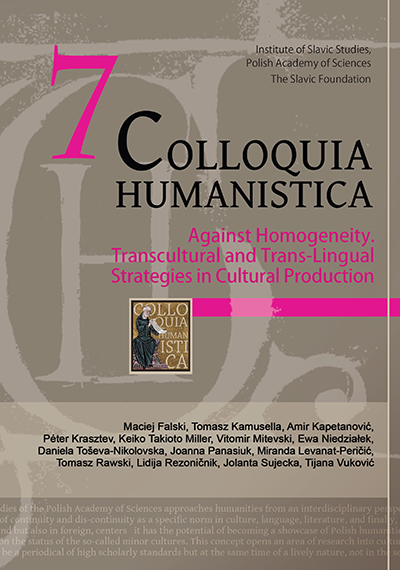As a Wall Came Down… New Boundaries, New Narratives
(Yugoslavism and the Yugoslav Artistic Space, Discontinuity and Fragmentation in the Core Narrative of Cultural Institutions in Transition-Period Serbia)
As a Wall Came Down… New Boundaries, New Narratives
(Yugoslavism and the Yugoslav Artistic Space, Discontinuity and Fragmentation in the Core Narrative of Cultural Institutions in Transition-Period Serbia)
Author(s): Tijana VukovićSubject(s): Anthropology, Recent History (1900 till today), Politics and society, Sociology of Culture
Published by: Instytut Slawistyki Polskiej Akademii Nauk
Keywords: Yugoslavism; transition; transformation; cultural institution; narrative; Yugoslav Artistic Space; discontinuity; crisis; cultural space;
Summary/Abstract: The main aim of this overview is to trace the presence and importance of Yugoslav narrative (dedicated to a common cultural and artistic space before, during and after Yugoslavia) as important for (re)creating and maintaining continuity and coherence in the core narrative as an internal structure of cultural institutions in Serbia, especially in the transition period (2000 – 2018). The emergence of the South Slavic unity idea in the territory of the Balkans, as we argue in the paper, can be traced to a time long before the state of Yugoslavia was created as a concept. The fact that a common Feld (common ground) in the sense of cultural space existed long before the creation of Yugoslavia contains the assumption that a common cultural ground and art space exist in the post-Yugoslav period as well. The concept of the common cultural space is also known as the Yugoslav Artistic Space. The main goal of the paper is to form the conclusion that the Yugoslav Artistic Space, considering its tradition, still exists despite the political changes after 1989, particularly during the 1990s and the transition process, if not in another sense then as a core narrative of institutions (such as the Museum of Contemporary Art in Belgrade, for example). The paper also offers the thesis that marginalization of the Yugoslav legacy leads to discontinuity, fragmentation, and a status quo position in the transition process of Serbian cultural institutions.
Journal: Colloquia Humanistica
- Issue Year: 2018
- Issue No: 7
- Page Range: 114-134
- Page Count: 21
- Language: English

